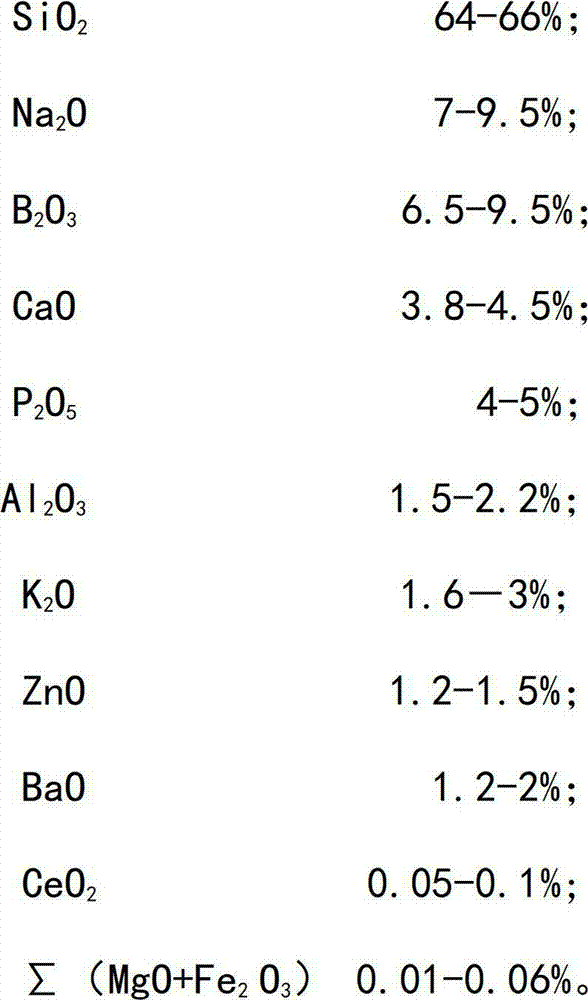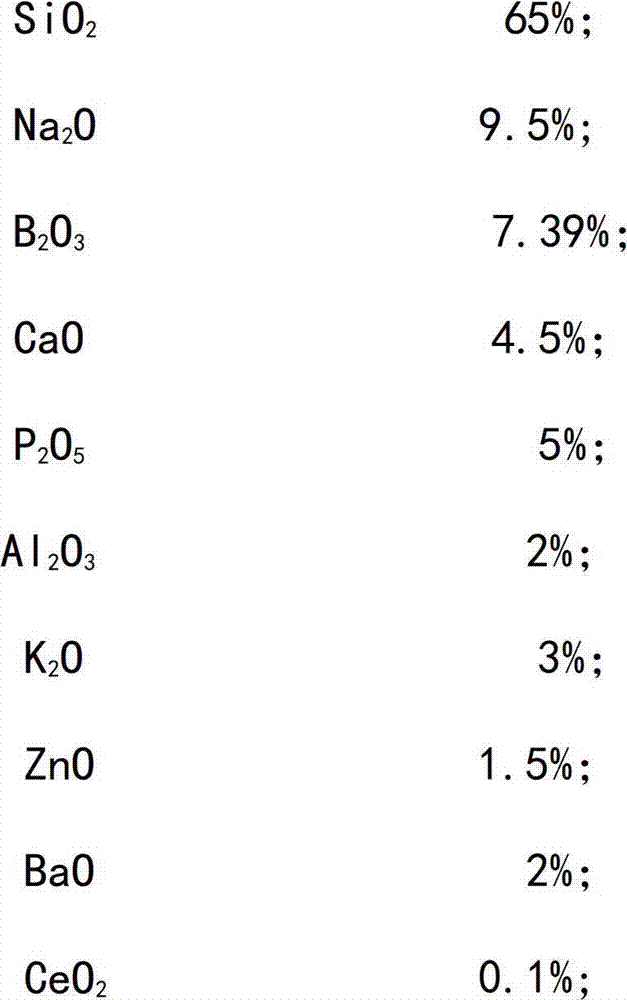White jade glass dishware
A glass and tableware technology, applied in the field of white jade crystal porcelain glass tableware, can solve problems such as dim prospects, fluoride environmental pollution, etc., and achieve the effects of delicate hand feeling, low production cost, and resource saving
- Summary
- Abstract
- Description
- Claims
- Application Information
AI Technical Summary
Problems solved by technology
Method used
Image
Examples
Embodiment 1
[0050]Take 66 parts of quartz sand, 8 parts of waste glass, 17 parts of borax pentahydrate, 14 parts of soda ash, 12 parts of ammonium dihydrogen phosphate, 9 parts of calcium carbonate, 4 parts of potassium carbonate, 1.3 parts of zinc oxide, 3 parts of aluminum oxide powder, carbonic acid Put 2.2 parts of barium and 0.06 parts of cerium oxide into the mixer for stirring, stop when the uniformity is greater than 95%, add a small amount of water as needed, and the water content is 3-4% of the batch. Put the evenly mixed raw materials into the furnace to melt, and the temperature of the furnace is controlled at about 1520°C, so that the material is melted into a liquid without bubbles and stones, and then cooled to 1300°C; when the raw material temperature is 1100°C, it is made by a centrifugal molding machine The dinner plate is heated and polished with fire after forming; the polished formed product is put into an annealing furnace for annealing, and the annealed formed produc...
Embodiment 2
[0052] Take 64 parts of quartz sand, 8 parts of waste glass, 19 parts of borax pentahydrate, 10 parts of soda ash, 9 parts of ammonium dihydrogen phosphate, 6 parts of calcium carbonate, 2 parts of potassium carbonate, 1.5 parts of zinc oxide, 1 part of aluminum oxide powder, Put 2.2 parts of barium and 0.06 parts of cerium oxide into the mixer for stirring, stop when the uniformity is greater than 95%, add a small amount of water as needed, and the water content is 3-4% of the batch. Put the uniformly mixed raw materials into the furnace to melt, and the temperature of the furnace is controlled at about 1510°C, so that the material is melted into a liquid without bubbles and stones, and then cooled to 1300°C; when the raw material temperature is 980°C, it is made by a centrifugal molding machine The dinner plate is heated and polished with fire after forming; the polished formed product is put into an annealing furnace for annealing, and the annealed formed product is put into...
Embodiment 3
[0054] Take 65 parts of quartz sand, 9 parts of waste glass, 21 parts of borax pentahydrate, 12 parts of soda ash, 11 parts of ammonium dihydrogen phosphate, 7.5 parts of calcium carbonate, 3 parts of potassium carbonate, 1.1 parts of zinc oxide, 2 parts of aluminum oxide powder, Put 2.3 parts of barium and 0.06 parts of cerium oxide into the mixer for stirring, stop when the uniformity is greater than 95%, add a small amount of water as needed, and the water content is 3-4% of the batch. Put the uniformly mixed raw materials into the furnace to melt, and the temperature of the furnace is controlled at about 1530°C, so that the material is melted into a liquid without bubbles and stones, and then cooled to 1300°C; when the raw material temperature is 1120°C, it is made by a centrifugal molding machine The dinner plate is heated and polished with fire after forming; the polished formed product is put into an annealing furnace for annealing, and the annealed formed product is put...
PUM
 Login to View More
Login to View More Abstract
Description
Claims
Application Information
 Login to View More
Login to View More - R&D
- Intellectual Property
- Life Sciences
- Materials
- Tech Scout
- Unparalleled Data Quality
- Higher Quality Content
- 60% Fewer Hallucinations
Browse by: Latest US Patents, China's latest patents, Technical Efficacy Thesaurus, Application Domain, Technology Topic, Popular Technical Reports.
© 2025 PatSnap. All rights reserved.Legal|Privacy policy|Modern Slavery Act Transparency Statement|Sitemap|About US| Contact US: help@patsnap.com



